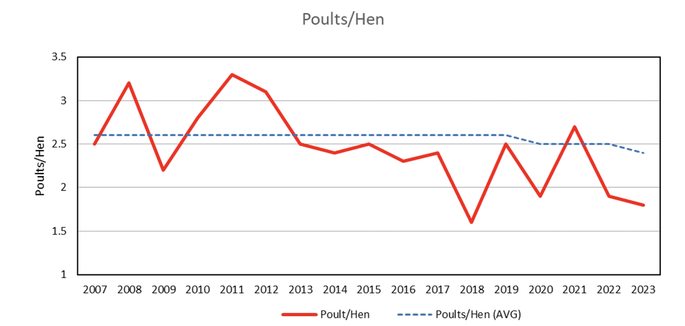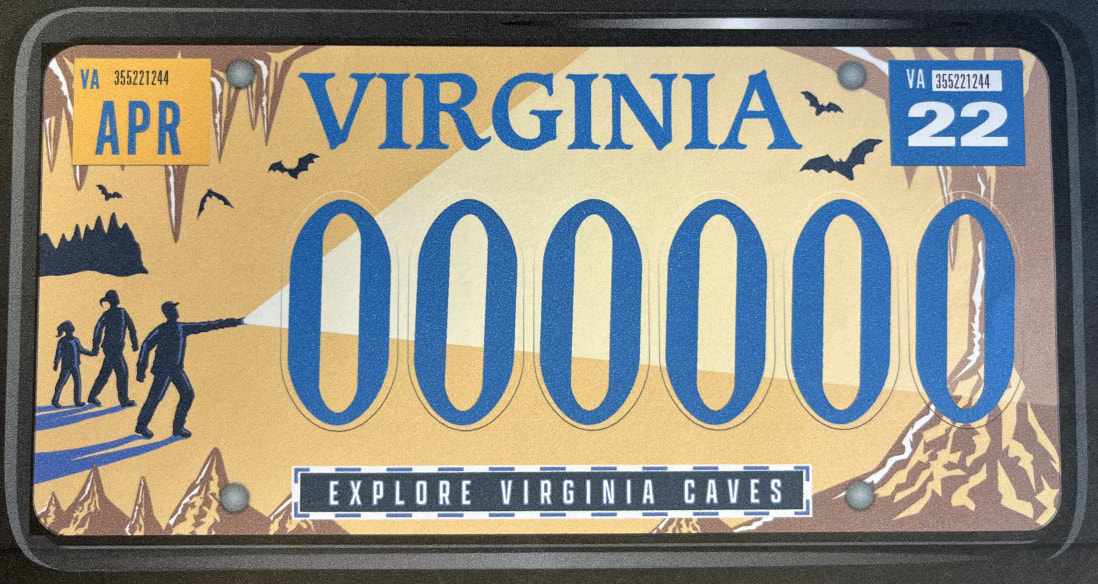 Figure 1. Poult/Hen ratio (2007-2023) with long term survey average. Graph provided by Virginia Department of Wildlife Resources.
Figure 1. Poult/Hen ratio (2007-2023) with long term survey average. Graph provided by Virginia Department of Wildlife Resources. Virginia Department of Wildlife Resources: Wild Turkey Summer Brood Survey Results
--By Katie Martin, Deer-Bear-Turkey Biologist and Mike Dye, Forest Game Bird Project Leader, Virginia Department of Wildlife Resources
Through the months of July and August, the Virginia Department of Wildlife Resources (DWR) staff and cooperators completed the annual turkey brood survey. The survey provides an index to productivity of wild turkey reproduction and can assist in making management decisions. The survey counts the number of turkeys observed by staff and cooperators as they go about their normal day to day business and is expressed as the number of turkeys observed per 1,000 miles driven and the number of poults (juvenile turkeys) observed per hen. The Department would like to thank the many volunteers of the Virginia National Wild Turkey Federation chapters, DWR Complementary Work Force and Hunter Education Instructors, numerous teachers, and the Virginia Master Naturalists for their survey participation in 2023! Volunteers account for more than one-third of the observers in the survey. Data is also collected by partners from VA state parks, VA Dept. of Forestry, and several military installations.
In 2023, the Department received 190 reports by observers driving over 221,000 miles during July and August. Sixty-six percent of observers reported seeing at least one turkey during the survey time period. The overall number of turkeys staff have observed in the summer has declined since 2015. In 2023, the total number of turkeys observed fell below the long-term average (17.7/1,000 miles) to 7.36 birds per 1,000 miles, an all-time low since survey inception in 2007. This ratio peaked in 2014 (29.4) and 2015 (30) and has been declining since (Fig. 2). The Tidewater Region had the highest ratio (24/1,000 mi.) and likely has the highest turkey population of any region in the state. The Southwest region had the next highest ratio with 8.7 birds per 1,000 miles, which is still lower than the 2022 ratio of 9.8 birds/1,000 miles for this region. The North Mountains (7.0), South Piedmont (4.6) and North Piedmont (3.1) were all significantly below the long-term survey average (17.7 turkeys per 1,000 miles). One bright spot is the increase (from 4.9 to 7 birds/1000 miles) for the North Mountain region.
The 2023 annual survey suggests reproduction for wild turkey declined to a statewide average of 1.8 poults/hen, falling below the long-term survey average of 2.4 poults/hen and nearly identical to the 2022 ratio (1.9). This is a nearly 30% decline though from the 2021 ratio (2.7) and becomes the second lowest P/H ratio on record, which was 1.6 observed in 2018 (Figs. 1 and 3). The Poult/Hen ratio is our best measure of reproduction as it considers the number of poults produced by all hens. Complete brood loss is not uncommon, and those situations need to be incorporated when evaluating reproduction.
Below average recruitment (P/H ratio) was reported across all regions in 2023 with the Tidewater having the highest (2.1) and the South Piedmont the lowest (1.4). Falling in the middle were the Southwest (2.0), Northern Mountains (1.8), and Northern Piedmont (1.9).
Wild turkey success in hatching and raising broods plays an important role in wild turkey populations and is especially important in fall harvests. Further, the ratio of young birds (poults) to the number of females (hens) is a critical index to reproduction (P/H). Lack of suitable nesting and brooding habitat continue to be likely factors in the decline of turkey reproduction across much of Virginia. For information on improving native habitats on your land visit: https://dwr.virginia.gov/wildlife/habitat/
This information is intended to monitor turkey population trends and densities but does not infer high hunter success or satisfaction while hunting. See the attached 2023 Wild Turkey Summer Brood Survey Results PDF for more information and graphs of the data.
--By Katie Martin, Deer-Bear-Turkey Biologist and Mike Dye, Forest Game Bird Project Leader, Virginia Department of Wildlife Resources
Through the months of July and August, the Virginia Department of Wildlife Resources (DWR) staff and cooperators completed the annual turkey brood survey. The survey provides an index to productivity of wild turkey reproduction and can assist in making management decisions. The survey counts the number of turkeys observed by staff and cooperators as they go about their normal day to day business and is expressed as the number of turkeys observed per 1,000 miles driven and the number of poults (juvenile turkeys) observed per hen. The Department would like to thank the many volunteers of the Virginia National Wild Turkey Federation chapters, DWR Complementary Work Force and Hunter Education Instructors, numerous teachers, and the Virginia Master Naturalists for their survey participation in 2023! Volunteers account for more than one-third of the observers in the survey. Data is also collected by partners from VA state parks, VA Dept. of Forestry, and several military installations.
In 2023, the Department received 190 reports by observers driving over 221,000 miles during July and August. Sixty-six percent of observers reported seeing at least one turkey during the survey time period. The overall number of turkeys staff have observed in the summer has declined since 2015. In 2023, the total number of turkeys observed fell below the long-term average (17.7/1,000 miles) to 7.36 birds per 1,000 miles, an all-time low since survey inception in 2007. This ratio peaked in 2014 (29.4) and 2015 (30) and has been declining since (Fig. 2). The Tidewater Region had the highest ratio (24/1,000 mi.) and likely has the highest turkey population of any region in the state. The Southwest region had the next highest ratio with 8.7 birds per 1,000 miles, which is still lower than the 2022 ratio of 9.8 birds/1,000 miles for this region. The North Mountains (7.0), South Piedmont (4.6) and North Piedmont (3.1) were all significantly below the long-term survey average (17.7 turkeys per 1,000 miles). One bright spot is the increase (from 4.9 to 7 birds/1000 miles) for the North Mountain region.
The 2023 annual survey suggests reproduction for wild turkey declined to a statewide average of 1.8 poults/hen, falling below the long-term survey average of 2.4 poults/hen and nearly identical to the 2022 ratio (1.9). This is a nearly 30% decline though from the 2021 ratio (2.7) and becomes the second lowest P/H ratio on record, which was 1.6 observed in 2018 (Figs. 1 and 3). The Poult/Hen ratio is our best measure of reproduction as it considers the number of poults produced by all hens. Complete brood loss is not uncommon, and those situations need to be incorporated when evaluating reproduction.
Below average recruitment (P/H ratio) was reported across all regions in 2023 with the Tidewater having the highest (2.1) and the South Piedmont the lowest (1.4). Falling in the middle were the Southwest (2.0), Northern Mountains (1.8), and Northern Piedmont (1.9).
Wild turkey success in hatching and raising broods plays an important role in wild turkey populations and is especially important in fall harvests. Further, the ratio of young birds (poults) to the number of females (hens) is a critical index to reproduction (P/H). Lack of suitable nesting and brooding habitat continue to be likely factors in the decline of turkey reproduction across much of Virginia. For information on improving native habitats on your land visit: https://dwr.virginia.gov/wildlife/habitat/
This information is intended to monitor turkey population trends and densities but does not infer high hunter success or satisfaction while hunting. See the attached 2023 Wild Turkey Summer Brood Survey Results PDF for more information and graphs of the data.

Virginia Department of Environmental Quality: MyDEQ Portal
--Contributed by Sharon Baxter, Virginia Department of Environmental Quality
DEQ is excited to announce an enhancement to the MyDEQ Portal. As you may know, the MyDEQ Portal is DEQ’s comprehensive, online reporting tool that is available to user 24 hours a day, seven days a week. This enhancement replaces the DEQ’s final orders webpage which documented the Agencies case decisions and how alleged violations were resolved. The enhancements main objectives are:
DEQ hopes that this MyDEQ Portal enhancement fosters positive relationships with the communities we serve. By actively engaging with the public, sharing information, and involving community members in decision-making processes, DEQ can continue to build trust and gain valuable insights, leading to more effective and community-oriented enforcement.
--Contributed by Sharon Baxter, Virginia Department of Environmental Quality
DEQ is excited to announce an enhancement to the MyDEQ Portal. As you may know, the MyDEQ Portal is DEQ’s comprehensive, online reporting tool that is available to user 24 hours a day, seven days a week. This enhancement replaces the DEQ’s final orders webpage which documented the Agencies case decisions and how alleged violations were resolved. The enhancements main objectives are:
- Increased transparency to serve as a crucial mechanism to foster public trust and confidence in DEQ enforcement actions. The public will now be able to see open enforcement actions, a contact person for additional questions, and view agency records.
- Enhanced public engagement and meaningful involvement, not only in the public notice/comment process but, now at the beginning of an enforcement action with the issuance of a Notice of Violation.
- Additional accountability goes hand in hand with transparency, as it ensures that permittees and other responsible parties are held responsible for their actions. It establishes clear expectations/consequences for those who deviate from the law.
DEQ hopes that this MyDEQ Portal enhancement fosters positive relationships with the communities we serve. By actively engaging with the public, sharing information, and involving community members in decision-making processes, DEQ can continue to build trust and gain valuable insights, leading to more effective and community-oriented enforcement.

Virginia Department of Conservation and Recreation Natural Heritage Program - Explore Virginia Caves Specialty License Plate
--Contributed by Anne Chazal and Emi Endo, Virginia Department of Conservation and Recreation
There’s a new Specialty License Plate proposed to help bring attention to the amazing caves we have in the Commonwealth. Be among the first to signup to receive this beautiful plate to show your support of our natural resources in Virginia. The plate will be a revenue-sharing plate where $15 of each plate sold will go to support the work of the Cave Board after 1,000 plates are sold.
We have designed the plate to support the Virginia Cave Board. The Virginia Cave Board works diligently in collaborating with multiple organizations and the Virginia Department of Conservation and Recreation to promote the conservation and protection of caves, karst, cave life and environmental education.
We must collect 450 pre-paid applications before the General Assembly will approve the plate for distribution. For an application and more information, visit the Virginia Cave Board site.
--Contributed by Anne Chazal and Emi Endo, Virginia Department of Conservation and Recreation
There’s a new Specialty License Plate proposed to help bring attention to the amazing caves we have in the Commonwealth. Be among the first to signup to receive this beautiful plate to show your support of our natural resources in Virginia. The plate will be a revenue-sharing plate where $15 of each plate sold will go to support the work of the Cave Board after 1,000 plates are sold.
We have designed the plate to support the Virginia Cave Board. The Virginia Cave Board works diligently in collaborating with multiple organizations and the Virginia Department of Conservation and Recreation to promote the conservation and protection of caves, karst, cave life and environmental education.
We must collect 450 pre-paid applications before the General Assembly will approve the plate for distribution. For an application and more information, visit the Virginia Cave Board site.


 RSS Feed
RSS Feed